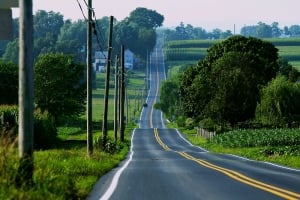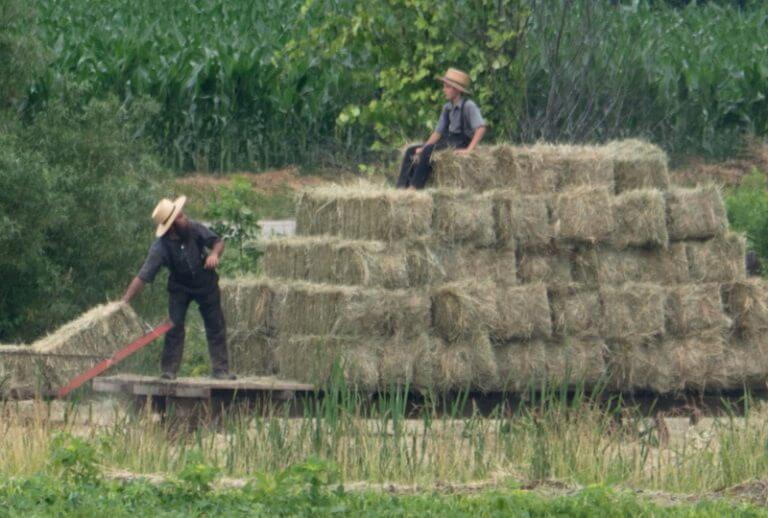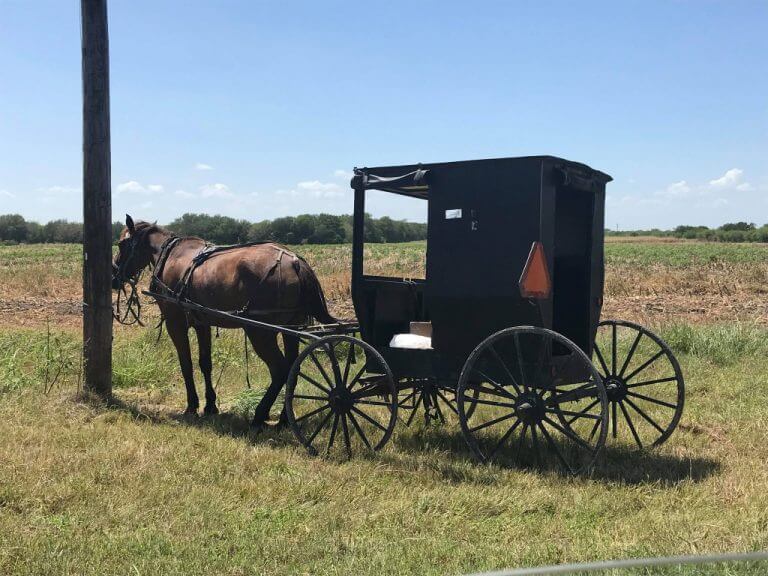The two Lancaster Counties
An imaginary line runs through Lancaster County. Some say it follows the route of highway 30, the old Philly artery which bisects the county. This theoretical divider splits the settlement’s Amish into conservative and more progressive groupings.
The north-south division may not be that cut-and-dry, but it is a real thing. Some say a stricter Ordnung and less contact with outsiders tend to make southern Lancaster Amish more insular in relation to their northern brothers and sisters.
One of my friends ‘near the line’ here in Lancaster tells me that when they go to visit his wife’s sister in the southern part of the community, they feel out of place. They’ll visit with people to the north of them, but the church district directly south they rarely see. Asking a farmer just south into the next district confirms this. ‘No, we don’t go up there much’.
‘Being in fellowship’, or being ‘back-and-forth’, is what it’s called if you are open and friendly with the neighbors, when you visit them for church, exchange ministers, and your sons and daughters marry theirs.
‘We’re back-and-forth with those people’
This goes for intra-settlement contact as well as within a particular community. Lancaster Amish are not too much back-and-forth with Holmes County, Ohio Amish, for example, though they do fellowship with the Andy Weaver affiliation Amish from that community. Lancaster people tend to be back-and-forth with Lancaster daughter settlements, such as those in Dauphin or various other PA counties, or the two settlements in Wayne and Parke Counties, Indiana. Those particular Amish have much closer ties to the Lancaster people, even though other Amish settlements in various Indiana locations are geographically much closer.
I’ve seen this same dynamic many times in other settlements. A more progressive business owner in northern Holmes County talks in terms of ‘those people’ when referring to those in the conservative deep south of the settlement. The idea is that ‘they’re different from us’. Contrary to what I once thought, there’s just no such thing as one big happy Amish family. Amish do talk in terms of ‘our people’ when referring to Amish in general compared to English or Mennonites, but lines of distinction are clear within this society.
I remember how back in early June one of my Holmes County friends seemed a bit wary when I mentioned I was going to see the Lancaster Amish. ‘They’re different’ out there, he said, listing off some differences– that ‘they all dress the same’, that they’re ‘very aggressive’ at business and even farming. He mentioned how a visitor once told him that she loves coming to visit Holmes County Amish, especially when compared to those in Lancaster. ‘They’re rude’ she said.
Painting people with such big brush strokes can be hazardous, of course. While there may be some truth in the stereotyping (I’ve never had so many Amish kids try to sell me stuff as this past summer in Lancaster), I can say that I’ve also met some of the absolutely nicest people you’d ever want to meet among the Lancaster Amish. This same Holmes County friend, who’d visited PA, also stressed that among their own, there is no one more hospitable than Lancaster people. ‘They’ll get everyone together and be up til 2 am when there’s company over, then get up on 4 hours sleep and be in great shape’.
A lot of the stereotyping and the ‘they’re different from us’ idea within Amish society is based partly on hearsay, partly on ignorance, and amplified by distance. But a lot of it is rooted in core differences in Ordnung. Daviess County, Indiana Amish, who aren’t too back-and-forth with those from relatively nearby Adams County, describe differences with that group rooted in a more conservative Ordnung, and which help to prevent closer ties between the two settlements.
Fellowship lines make a real difference in everyday Amish life, affecting everything from who you visit to who you marry, as in my Lancaster friend’s example. Donald Kraybill in The Riddle of Amish Culture calls the north-south ‘divide’ one of the three main points of tension within the Lancaster Amish community. ‘If not mediated carefully by the settlement-wide Bishops’ Meetings, [the north-south dichotomy] has the potential to divide the settlement’, says Kraybill.
There truly are 31 flavors of Amish, and fellowship lines help to preserve the differences, keeping things interesting at the same time. The diversity within Amish society also allows many types of people to find a place within the Amish world. ‘Amish’ does not mean ‘one-size-fits-all’, and this is probably a good part of the reason why the Amish are able to thrive today.










I wonder who put the 31 flavors of Amish together, although that is probably pretty accurate. I live in Sarasota Florida and so I get to taste all the liberal Amish flavors.
Where in Parke County are there Amish settlements?
When we were visiting Adams County earlier this summer, my wife learned about two different Shipshewana women who had married into the community around Geneva. One tried opening her own business, which failed because the people there refused to have anything to do with it. The other may have started her own business, too (I disremember and I’m telling this at 4th hand) but was a little better accepted — not that it was easy for her.
Talk about a culture clash! Those Shipshewana people are pretty wild in comparison to the ones in the south part of Adams county.
Hi Katie,
Of course the 31 flavors is my own approximation/adaptation of a convenient pop culture slogan…the number’s not exactly accurate but you get the idea, (thank you very much Baskin Robbins)! Especially living in Sarasota–you must see all styles of dress in that Amish ‘melting pot’.
Katie, I wanted to ask you–do you see a lot of Amish children in Pinecraft area? I’ve always had the impression that there’d be fewer as it seems to be more a place for older/seasonal Amish..? In any case I guess there’s only one district anyway–but I see from my most recent Calender that they’ve got three ordained bishops in that one district!
That “Patchwork” book sounds interesting. Now I’m conflicted! Do I want to read it to help me understand what I’m seeing when I ride in Indiana? Or do I want to first do some more rides so I can learn by watching (and maybe talking with people, too) and then see if my observations are confirmed by others? I’m planning a few outings in Indiana for the next two months, and had already planned for one of them to be based at Rockville. I rode through Parke county last year on a history trip, but must have gone a few miles to the east of the Amish places you listed.
Amish in Parke County-Rockville, Indiana
The Parke County Amish are generally associated with the town of Rockville. My Calender also tells me some have Marshall addresses so that gives you an idea on the geography of it. There are currently five districts. As I recall from my visit a few years back it’s a beautiful rural setting and also known for being the county with the most covered bridges in the US (one more than Lancaster apparently).
That doesn’t surprise me about the Adams/Lagrange differences. I’m just reading in ‘An Amish Patchwork’, a book on the very diverse Indiana Amish, that Adams County actually has five different affiliations. I’d met some Adams County transplants in Lagrange but only in the more conservative eastern side of the settlement.
The ‘Amish Cook’, (Lovina Eicher–of Michigan) is actually originally from the Adams settlement–I’ve always wondered if she’d be able to write and publish the column if she still lived there.
I know of only three Amish families living here year round that have school age children or younger. 99% are old folks or singles. During the peak tourist season the Amish church was over flowing with 600 people present. Naturally they had to sit out in the yard and so for the last two winters they have opened up another home for church services during the peak season. Then also some of the overflow attends the Tourist Mennonite church services. You pretty well do what you want to do down here and get by with it.
Hi, please tell us more about your “calender” – who, where, when, and how much $ ?
Thanks, Bruce
John either way you’ll have a great time. When I first went to some of these communities I did not always know about some of the Ordnung differences and differences in origin so it was neat to discover on my own. I do like the Patchwork book though, the guys that wrote it, Steven Nolt and Thomas Meyers, are top notch.
Katie that is interesting to hear, Pinecraft has always seemed to me a sort of ‘pseudo-Amish’ community for lack of a better term, with its mix of different Ordnungs, tricycles instead of buggies and seasonal/retirement aspect.
Amish Calender at dry goods shops
Bruce,
Sorry it took me a bit to respond. The Calender comes out yearly and it is something of an Almanac with some weather stuff and German hymn listings, but the bulk of it is a state-by-state address listing of Amish church districts and ministers. I mail ordered my latest one from Ohio earlier this year, a place called Raber’s Book store out of Baltic. You can get them in other Amish dry goods shops as well. I don’t have the Raber’s address handy but will try to post when I do. It’s more of a booklet and costs just a few bucks.
Bruce–on the Calender–Raber’s address:
Ben J. Raber
2467 CR 600
Baltic, OH 43804
Gordonville Print shop is the one that prints it apparently:
Gordonville Print Shop
3119 Irishtown Rd.
Gordonville, PA 17529
Don’t know exact price but when I ordered from Raber I enclosed ten bucks and that covered the Calender, three other pamphlet-books, and the shipping to NC.
The Holmes County "dividing line"
When I was running around with the Amish young people of Holmes County, (1952-56) there were virtually two Amish settlements. To the southwest of us was the more backward area, a triangular araa defined by Farmerstown, Charm and New Bedford at the corners. To the north and east of us were the more progressive Amish young people – “our kind.” We didn’t mix much with those of the backward triangle. We used to say that they were “flat-dutchich”, a somewhat disparaging term, suggesting they were just not quite as good as we were! How childich that seems now!
South Holmes County Amish
Very interesting Henry, thanks for sharing this. Based on how I hear it talked about, this seems to generally still holds true now in terms of the more conservative area, though I wonder if youth mix more now? Would Farmerstown / Charm still land in this more conservative area? I think the churches stretching past New Bedford into Coshocton County would be among the more conservative as well (leaving out Swartzentruber, etc). Just doing some quick reverse-math I guess there were closer to 30-40 Holmes County churches in the period you describe vs. the 200+ today. Quite a difference!
I don’t have a good sense whether the young people mix more freely now or not. I think it may be less of a geographic issue as some other, more subtle, factors. The further south you go, the more rugged the lay of the land, and it gets really rugged some places south of New Bedford. Farming down there is more traditional, a little more in the direction of subsistence farming, whereas up toward Mt. Hope farming is more produce oriented for the auction, and generally more progressive.
on Horses in Pinbecraft
I went out on U-tube to see several Ernest Bontrager vids, I searched Pinecraft w/ Google Maps street view, seeing Tourist Church, the Amish meeting house and even Katy Troyer’s house and Concluded they simply don’t have any place to board or pasture horses! I suspect also Sarasota may have an anti-horse ordinance.